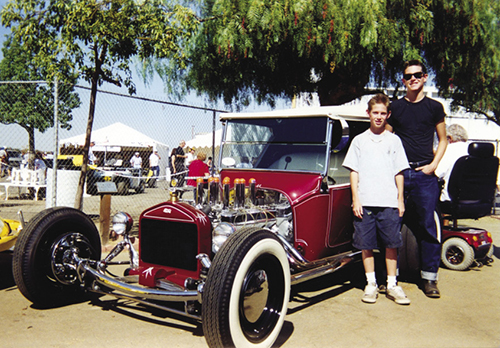◄ Back to Driving Force, Summer 2015
Filling the Generation Gap
Solving the “Classic” Car Question: Who and What’s Next?
By Colby Martin
 |
|
| No, the two youngsters above were not “dragged” into posing with the quintessential T-bucket shown here at the 1999 California Hot Rod Reunion. Being the high schooler on the right, my brother and I were honored to stand beside “TV Tommy” Ivo’s iconic roadster—we already had learned that it helped inspire a style that has lasted six decades. Moments like this have allowed me to personally connect with a time that I couldn’t experience firsthand, in this case 1956. | |
|
|
Can you believe that FM radio stations playing “oldies” now commonly include songs from the likes of Aerosmith, Journey and Madonna among their rotation? That chord was struck (pun intended) when I began realizing that I rarely heard the originators of rock ‘n’ roll on the usual play lists. You know, Buddy Holly, Chuck Berry and ’50s-era Elvis tunes. This realization helped shape my gradual move away from terrestrial radio and into other methods of enjoying music. Like most others, I tend to bounce between a variety of musical genres based on the mood of the moment. I admittedly still get a bit hung up on labels that define a particular style. But, I feel very differently when it comes to my beloved automotive pastime. Maybe that’s what a decade of working for a group like SEMA will do to a person. These days, I’m much more open minded to treatments outside my natural “wheelhouse.”
Over the years, I’ve noticed a lingering anxiety among members of the car community regarding the makeup of the next generation of enthusiasts and what they will drive/collect? This growing concern is spurred by the notion that today’s youngsters won’t carry the torch forward. At my office, Next Gen (i.e. next generation) is the industry’s buzz word for the topic and it appears constantly. The “what” part of the question is fairly easy to answer. As the cover story of this issue details, states continue to target vintage vehicles as revenue streams and contributors to smog. Vintage tin and donor parts have steadily become scarcer with time. While some of today’s models could hold value as future collectors, there are also an assortment of well-made reproductions, recreations and innovations now available to suit anyone’s taste. Want an early Ford roadster, a Tri-Five Chevy or even a Chrysler Hemi? These iconic offerings are available brand new again.
Now the “who” part of the question is obviously younger drivers, often referred to as Generation Y or Millennials. They are the successors to Generation X and are currently between the ages of 18 and 34 years old. By definition, I fall into this group, although those who know me will agree that I’m not very representative of the bunch. Call me old fashioned.
Many high-profile automotive media outlets have referenced a recent report from MTV about this emerging economic powerhouse. Contrary to popular belief, they too continue to see car ownership as a way to establish independence and shape their unique adult identity. In fact, 75% would rather give up social media for a day than their cars, and 72% said that they would rather give up texting for a week than their cars. This set uses social networks as virtual “online car clubs.” With the Internet serving as host, these avenues are always open for impromptu vehicle-focused “meetings.”
My peers and I came of age in a time of a rebounding domestic auto market, summer blockbuster films and video games. Each has had a distinct and long-lasting effect. In the ’90s, supercar posters adorned pre-teen bedroom walls. The likes of the Dodge Viper, Corvette ZR-1, Acura NSX, Jaguar XJ220, Ferrari F40, Lamborghini Diablo and others deeply inspired this new car culture. In fact, the Viper is only two years away from turning 25. I’ve followed its development since the first concept images were made public. Others lusted for the late actor Paul Walker’s ’93 Toyota Supra from the film The Fast and the Furious. Released in 2001, an argument can be made that the film will be as generation-defining as previous iconic features like American Graffiti, Bullitt, Vanishing Point or Smokey & The Bandit. The myriad of popular driving simulator-style video games will be equally important in defining tomorrow’s collectibles.
From my perspective, the future of this great hobby appears intact. Everyone can still create a dream car to suit their own specific taste. There is a renewed interest in the driving aspect of specialty cars these days, much to the delight of folks in my age bracket. So much fun can be experienced by touring, autocross, reliability runs, racing on a track and more. A lot of focus is now placed on a machine’s handling too. Just look at the booming restomod trend, where modern technology—primarily powerplants and suspension components—is adapted to old iron. The recent musclecar resurgence has created new fanatics. Should we not protect these collector cars of the future, such as exciting recent offerings like the Chevy COPO Camaro, Dodge Challenger Hellcat and Nissan Skyline GT-R? I’m betting they’ll have a following for many years to come.
While many car enthusiasts may not fully comprehend the current trends of Millennials, don’t lose faith. These new enthusiasts will define the future of the auto hobby with new ideas and packing an even wider appreciation of what defines automotive perfection. And, if they’re looking for inspiration from the past, the entire history of the automobile can be accessed using only their thumbs and a mobile device.
—IGNITED WE STAND!
